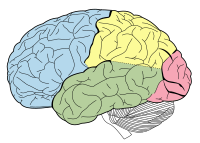
Photo from wikipedia
Arousal levels strongly affect task performance. Yet, what arousal level is optimal for a task depends on its difficulty. Easy task performance peaks at higher arousal levels, whereas performance on… Click to show full abstract
Arousal levels strongly affect task performance. Yet, what arousal level is optimal for a task depends on its difficulty. Easy task performance peaks at higher arousal levels, whereas performance on difficult tasks displays an inverted U-shape relationship with arousal, peaking at medium arousal levels, an observation first made by Yerkes and Dodson in 1908. It is commonly proposed that the noradrenergic locus coeruleus system regulates these effects on performance through a widespread release of noradrenaline resulting in changes of cortical gain. This account, however, does not explain why performance decays with high arousal levels only in difficult, but not in simple tasks. Here, we present a mechanistic model that revisits the Yerkes-Dodson effect from a sensory perspective: a deep convolutional neural network augmented with a global gain mechanism reproduced the same interaction between arousal state and task difficulty in its performance. Investigating this model revealed that global gain states differentially modulated sensory information encoding across the processing hierarchy, which explained their differential effects on performance on simple versus difficult tasks. These findings offer a novel hierarchical sensory processing account of how, and why, arousal state affects task performance. Author’s summary Over a hundred years ago, it was first observed that the effect of arousal on performance depends on task difficulty: the Yerkes-Dodson effect. Difficult tasks are best solved at intermediate arousal levels, whereas easy tasks benefit from a high arousal state. Current theories on how arousal affects neural processing cannot explain this effect of task difficulty. Here, we implement a key effect of arousal on cortical processing, a change in neuronal gain, in a computational model of visual processing capable of object recognition. Across a series of experiments, we find that our model can reproduce the Yerkes-Dodson effect behaviorally and that this effect can be explained by where in the processing hierarchy different arousal states optimize sensory information encoding.
Journal Title: PLoS Computational Biology
Year Published: 2022
Link to full text (if available)
Share on Social Media: Sign Up to like & get
recommendations!